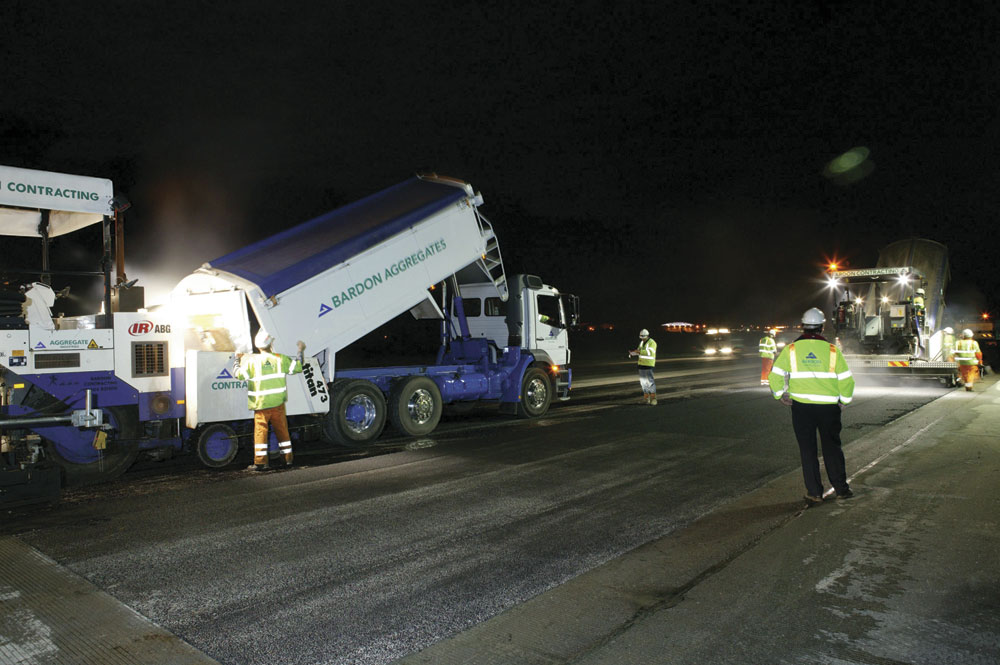Exeter Runway Receives Super-Strength Treatment

Recent advances in materials engineering have led Exeter Airport to specify a durable new asphalt surfacing to renew part of its runway, writes Mike Walter
A fully laden Airbus A310 passenger aircraft can weigh as much as 123 tonnes and exerts considerable force on an airport runway when the wheels of the plane touch down. Airport authorities take no chances over the quality of surfacing specified on airfields and a few airports, such as Exeter, are keen to try out the latest, most durable asphalt materials available when resurfacing is called for.
Last October Bardon Contracting laid Super AirMat, a recently developed asphalt surfacing material, for the first time on a section of runway at Exeter Airport. The material, which contains a durable variety of aggregate and a special polymer-modified bitumen binder, has been designed by Bardon Aggregates in association with Nynas Bitumen.
Super AirMat contains a 10mm nominally sized gritstone with a very high polished-stone value supplied by Bardon Aggregates in South Wales. This provides the surfacing with the exemplary level of grip demanded by airport authorities for material used to resurface runways. The aggregate is coated with Nynas Bitumen’s Nypol TS durable binder, which is designed to give good adhesion and cohesion with the stone. Added durability is afforded to the asphalt mix by the addition of cellulose fibres.
Resurfacing runways using Super AirMat helps airport authorities prolong the life of their assets and ensures the highest standards of safety for aircraft. Chris Mellor, Bardon Aggregates’ regional technical manager, said: ‘Super AirMat has been designed especially for use on airfields and is a very durable asphalt material that holds the aggregate firmly in place. Laying the asphalt is a one-pass process. Two pavers work in echelon to minimize the number of longitudinal joints in the material and, once laid, the material does not have to be grooved as with the alternative Marshall asphalt.’
The Nypol TS binder used to coat the aggregate is a polymer-modified grade of bitumen. Properties contained within the binder cause it to become thixotropic when not under sheer loading, which helps to prevent it draining from the stone when asphalt is being delivered to site. When mechanical action is applied — during paving and compaction — the binder becomes less viscous to make the asphalt more workable.
Nynas Bitumen’s product application manager for performance asphalts, Jukka Laitinen, commented: ‘Asphalt material containing the Nypol TS binder can be compacted quickly, which helps surfacing crews who are working within a restricted timescale. The contractor at Exeter Airport would have faced stiff financial penalties if the runway resurfacing had overrun. We made up to four deliveries of bitumen each night to a nearby asphalt production facility to help ensure that enough asphalt material would be delivered to site in time.’
Bitumen and aggregate were mixed together for the Exeter Airport contract at two dedicated asphalt production plants belonging to Bardon Aggregates at Westleigh Quarry, close to the nearby village of Burlescombe. A total of 1,500 tonnes of asphalt were supplied to the site during two weekend overnight closures of the runway.
Resurfacing at Exeter airport was carried out by Bardon Contracting on a 660m long section of the runway that measured 20m in width. Works were carried out following a successful trial of the material on a part of a disused runway at the airport. Runway resurfacing began with the planing out of 50mm of existing Marshall asphalt surfacing, which was taken away to an on-site tip for later reuse as low-grade material. A polymer-modified bitumen bond coat was then applied to the base before the new Super AirMat surfacing was laid to a depth of 50mm. Bardon Contracting’s operations manager, John Rae, said: ‘The team on site aimed to complete resurfacing works at 4am each Sunday morning to allow for the new material to cool. The runway was then swept carefully and line markings reinstated ahead of aircraft being allowed to use the runway 2h later.’
Exeter is one of the UK’s fastest growing regional airports. Passenger numbers have increased three-fold in the past few years and the airport’s first 1 million passengers a year should be reached in 2005/06.?Work?to extend the front of the main terminal building?was completed last autumn to accommodate additional passengers and construction is due to start this winter on a new outbound baggage-handling bay, additional aircraft stands and improvements to the airport’s fuel storage facility.
Nynas UK AB, North Road, Ellesmere Port, South Wirral, Merseyside CH65 1AJ; tel: (0151) 327 3171; fax: (0151) 327 5891
